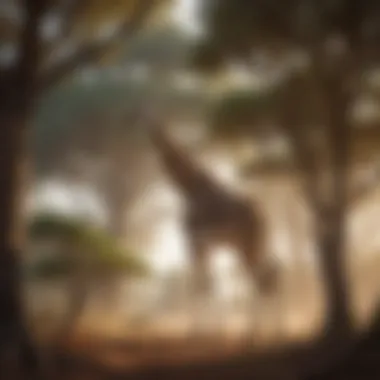Exploring Giraffe Leg Evolution: Nature's Design


Intro
The phenomenon of giraffes’ long legs is a topic of considerable interest within the field of evolutionary biology. Their elongated limbs not only serve as a remarkable characteristic of this iconic species but also provide critical insights into their adaptations for survival in the wild. This article delves into the evolutionary significance behind these long legs, focusing on anatomical structures, ecological advantages, and the mechanisms of natural selection that have shaped this trait over millions of years.
Understanding the intricate relationship between a giraffe's limb length and its lifestyle enhances our appreciation for the natural world. This discussion will integrate discussions from various studies and established principles in evolutionary theory to present a comprehensive perspective on this unique adaptation.
Key points to be discussed include:
- The anatomical adaptations that contribute to the giraffe's leg length.
- The ecological benefits these long legs provide in their natural habitat.
- The role of natural selection in the evolution of this trait.
- A review of existing research and theories relevant to giraffe leg evolution.
As we proceed, we aim to illuminate how these traits are not just peculiarities but vital components of the giraffe’s ability to thrive in its environment.
Preamble to Giraffes and Their Unique Physiology
Giraffes are remarkable creatures, distinguished by their long legs and necks. Understanding their physiology is crucial for several reasons. Firstly, these physical attributes are not mere accidents of nature; they play vital roles in the survival of the species. The anatomy of giraffes reveals how they have adapted to their environment over millions of years.
In this article, we explore various aspects of giraffes' anatomy. We focus on the ways their long limbs support their feeding habits, help them thrive in their habitat, and contribute to their social behavior. Connecting these elements helps illustrate the interplay between form and survival in giraffe evolution.
Overview of Giraffe Anatomy
Giraffe anatomy stands out in the animal kingdom. Their legs can reach a height of up to six feet. This extraordinary limb length contributes significantly to their survival. Long legs provide giraffes a height advantage to reach leaves and vegetation that other herbivores cannot access.
The overall body structure of spiders includes a proportionately smaller torso balanced by their long limbs. Their skin is also unique; it is adapted to protect them against harsh sun. The arrangement of muscles and joints in giraffes allows for efficient movement despite their significant height.
Here are key features of giraffe anatomy:
- Height: Adult giraffes can reach up to 18 feet tall.
- Neck Length: Their neck bones (cervicals) are elongated, with vertebrae that are large, long, and flexible.
- Leg Structure: Giraffes have two primary types of leg bones: the femurs (thigh bones) and metacarpals (foot bones).
- Circulatory System: Their heart is large and powerful to pump blood up to their heads.
This unique anatomy showcases how giraffes have evolved to meet environmental demands effectively.
The Significance of Limb Proportions
The limb proportions of giraffes are significant in many ways. Their long legs are an evolutionary adaptation that offers several advantages in their natural habitat. One of the primary functions of these long limbs is to help giraffes access food that would otherwise be out of reach. They primarily feed on leaves from tall trees, such as acacias.
In addition to feeding, long legs provide giraffes with heightened visibility. They can see over tall grasses, thus spotting predators from great distances. This advantage is vital for their survival in the wild. Furthermore, long legs enable giraffes to move swiftly across vast distances in search of food and water, which is essential in semi-arid environments where they are commonly found.
In summary, the significance of their limb proportions goes beyond mere aesthetics. It reflects a refined evolutionary response to ecological challenges. The adaptations in limb length and structure highlight their evolutionary journey fueled by natural selection.
"The giraffe's long legs and neck are not just for show; they are essential for survival in the wild."
Understanding these aspects informs conservation efforts and efforts to protect their habitats. A thorough comprehension of giraffe physiology also enhances knowledge of their ecological roles and interactions with other species.
The Evolutionary Context of Giraffe Limbs
The evolutionary context of giraffe limbs is fundamental in grasping why these animals exhibit such distinct physical characteristics. Understanding this context involves analyzing the adaptations that enable giraffes to thrive in their environment. The long legs of giraffes are not mere anomalies; they represent millions of years of evolution driven by survival needs. By exploring historical and ecological components, we can better appreciate how these attributes contribute to their existence.


The Fossil Record and Ancestral Traits
The fossil record presents invaluable insights into the evolutionary history of giraffes. The ancestors of modern giraffes can be traced back to the Miocene epoch, roughly 25 million years ago. Early ancestors, such as the Mammuthus, displayed shorter limbs and a more compact body structure. As the landscape evolved and grasslands expanded, those animals that adapted by developing longer legs were better suited for survival. Fossils like Giraffa brisoni and Giraffa jumae exhibit intermediate traits, bridging the gap between the ancient species and contemporary giraffes.
Studies of these fossils reveal that limb length directly correlates with ecological changes. In regions where vegetation grew taller, those giraffes with extended limbs could reach higher branches for feeding. This shift towards longer legs marks a significant evolutionary advantage, emphasizing how adaptation is contingent on environmental pressures.
"Limb length in giraffes is a prime example of how adaptation occurs in response to ecological shifts and food availability."
Natural Selection and Adaptive Traits
Natural selection plays a critical role in shaping the long legs of giraffes. This process selects for traits that enhance survival and reproduction. The ability to reach elevated foliage gives giraffes access to food sources unavailable to shorter herbivores. In competitive settings, such as during droughts or in environments with limited resources, these traits provide a direct benefit.
Additionally, long legs facilitate various adaptive behaviors. For instance, giraffes can maintain better visibility over their surroundings, spotting potential predators from greater distances. This heightened vigilance is integral to their survival. Furthermore, their long limbs allow for a unique gait, enhancing their mobility across vast savannas.
The evolutionary significance of giraffe limbs exemplifies the intricate relationship between anatomy and survival strategies. The selection pressures over time have molded giraffes into large, agile creatures capable of navigating their environment proficiently. This process highlights the essential nature of functional anatomy in natural selection and adaption.
Functional Benefits of Long Legs
The long legs of giraffes serve several functional benefits that enhance their survival. This section will discuss these advantages in detail, particularly focusing on ranging and feeding patterns, as well as defense mechanisms. Understanding how these traits contribute to the giraffe's lifestyle in the wild will provide insight into not only their physical adaptations but also their evolutionary success.
Ranging and Feeding Patterns
Accessing Tall Vegetation
One of the most significant aspects of long legs is the ability to access tall vegetation. This trait allows giraffes to reach leaves and branches that are beyond the reach of many other herbivores. In ecosystems where tall trees are prevalent, giraffes can exploit a food source that is less available to their competitors. This selective feeding gives them a distinct advantage in foraging efficiency.
The characteristic height of giraffes enables them to feed on foliage that is often unscathed, providing them with necessary nutrients and energy while minimizing competition.
Accessing tall vegetation is especially beneficial during dry seasons or in ecosystems with limited resources. By reaching this food source, giraffes can survive when other herbivores struggle. However, this dependency on height also comes with disadvantages; if taller trees are removed, food sources become less accessible, posing a risk to their survival.
Efficient Foraging Strategies
Long legs also facilitate efficient foraging strategies among giraffes. Their height allows them to survey large areas for food while on the move. This mobility enables giraffes to locate food sources quickly, thus improving their foraging efficiency. When searching for food, they can utilize their long legs to travel greater distances without expending excessive energy.
The key characteristic of this foraging strategy is the combination of height and speed, which allows giraffes to adapt to changing environments. As they graze, they easily transition from one feeding area to another, optimizing their energy intake.
Despite these advantages, there are drawbacks to consider. Increased movement may expose giraffes to predators, as they become more noticeable in the landscape. Thus, while their legs are beneficial for foraging, they may also pose risks.
Defense Mechanisms in the Wild
Heightened Vigilance
Long legs contribute to heightened vigilance among giraffes. The height advantage allows them to survey the surrounding area for potential threats. From an elevated position, they can spot predators from a long distance, which is crucial for their survival. This visual advantage is a significant benefit in the open savannahs where they often reside.
The key characteristic of heightened vigilance is the ability to maintain awareness while feeding or engaging in other activities. This means they can continue consuming food while also watching for dangers.
However, prolonged vigilance can be demanding on energy resources as well. They must balance the need to eat with the need to stay alert, which can lead to trade-offs in feeding time and energy conservation.


Escape from Predators
Escape from predators is another critical functional benefit afforded by their long legs. When threatened, giraffes can utilize their speed and agility to evade danger. Their long strides allow them to cover substantial ground quickly, making it difficult for many predators to catch them.
The unique feature here is their ability to outrun and outmaneuver threats effectively. Giraffes do not just run; they can also use their height to navigate through the underbrush more effectively than shorter animals.
That said, there are challenges involved, especially when the terrain becomes difficult to navigate. While their height and speed offer significant advantages, the physical demands of running can be taxing, and unexpected hurdles in their environment can lead to disadvantages.
Giraffes have evolved numerous adaptations that allow them to thrive in their environment. Their long legs are not only a characteristic feature but also a cornerstone of their survival mechanisms.
Comparative Anatomy: Giraffes versus Other Herbivores
Understanding the comparative anatomy of giraffes in relation to other herbivores offers crucial insight into their unique adaptations and evolutionary journey. Giraffes stand out among their peers due to their distinctive limb structure. This specialization plays a significant role not only in their height but also in their feeding habits, social behaviors, and survival strategies. By assessing the anatomical features of giraffes against those of other herbivorous species, we gather knowledge on how various evolutionary pressures have shaped their physical forms.
Limb Length in Other Species
Zebras and Antelopes
Zebras and antelopes display shorter legs compared to giraffes, which allows them to react quickly and escape predators effectively. Their limbs are built for speed, enabling quick changes in direction that are essential for survival in the wild. While giraffes may have greater reach for foraging, zebras and antelopes benefit from agility, making them less vulnerable in their respective habitats. This creates a fascinating contrast where giraffes specialize for height while other species emphasize rapid movement. Their short legs make them suitable for diverse terrains, offering survival advantages that giraffes might not have in certain contexts.
Impact of Habitat on Limb Proportions
The habitat significantly influences limb proportions in herbivores. Giraffes occupy environments with tall vegetation, which drives the development of long legs for browsing foliage. In contrast, animals like zebras, which inhabit grasslands and plains, benefit from shorter and more powerful limbs. These adaptations reflect the necessity of efficient foraging and escaping predators.
Long legs, while advantageous for reaching high leaves, come with trade-offs. They can hinder maneuverability in thick bush or forested areas. Thus, the type of environment shapes not only the diet of a species but also its physical form, an important consideration in evolutionary biology.
Evolutionary Trade-offs in Height
The evolution of height in giraffes represents a balance of various ecological roles. Longer legs enable the ability to access food, but they also impose constraints during movement. Giraffes face challenges when running from predators compared to shorter-legged herbivores. Their legs are less efficient for quick escapes, which can lead to higher predation risks in certain scenarios.
The benefits of height and the capability to reach food high in trees need to be weighed against the disadvantages of slower, more cumbersome movements. In the context of survival, these factors collectively shape giraffe anatomical development, leading to the extreme characteristics observed today.
The trade-offs in height among giraffes and other herbivores illustrate the complexity of evolutionary adaptation.
In summary, looking at giraffes alongside other herbivores helps clarify how different environments and survival strategies influence anatomical traits. This comparative analysis enriches our understanding of the giraffe's unique evolution and informs conservation efforts by showing the importance of maintaining diverse habitats for herbivorous species.
The Role of Long Legs in Social Behavior
The significance of long legs in giraffes extends beyond mere anatomy; they play a vital role in the social dynamics of these animals. Long legs influence how giraffes communicate, establish hierarchy, and engage in courtship. Understanding these processes provides insights into their behavioral ecology and adaptability.
Visual Communication Among Giraffes
Giraffes utilize their height for visual communication in their social groups. Their long legs elevate their bodies, allowing them to see over vast distances, which is crucial for scanning the environment for potential threats or other giraffes. This visual advantage facilitates the interaction within groups of giraffes. Giraffes can signal one another over long distances through subtle movements and postures that are often hard to interpret by ground-dwelling animals.
The height gained through long legs improves their ability to see and relay important social cues. For example, a giraffe standing tall can observe others and display body language effectively. These non-verbal signals include neck positioning, walking patterns, and other gestures. Through these methods, giraffes can maintain social bonds and establish dominance without the need for direct confrontations.
Mating Rituals and Courtship Displays


Long legs are particularly significant during mating rituals. Males often engage in "necking," a display of strength where they swing their necks to strike each other. The impact is most effective when utilizing their height and leverages of their long legs. This behavior not only establishes dominance but also attracts potential mates.
The visual aspect of these displays is striking, as taller males often have an advantage in attracting females. Females may prefer partners that display greater height and strength, which are expressed through these rituals. This preference emphasizes how long legs contribute directly to reproductive success. Additionally, successful courtship often involves running and dancing, which further highlights the functional benefits of their long limbs.
Overall, long legs in giraffes are fundamental to their social behavior, influencing communication and reproductive strategies. Observing how these animals adapt their physical traits for such purposes can provide valuable insights into their evolution and social structures.
Conservation Implications of Giraffe Physiology
The conservation of giraffes holds significant importance in terms of ecological balance and biodiversity. Giraffes, with their unique physiology, play a crucial role in their ecosystems. Their long legs not only aid in accessing food from tall trees but also allow them to maintain a lookout for predators. Understanding how their physiology influences their survival can inform conservation efforts and strategies.
Threats to Giraffes and Their Habitats
Giraffes are facing multiple threats that jeopardize their existence. These include habitat loss, poaching, and climate change. Habitat loss occurs primarily due to human activities, such as agriculture and urban expansion. As forests and savannas are transformed into farmland, giraffes are left with fragmented habitats that hinder their movement and access to food.
Poaching remains another serious issue. Giraffes are hunted for their skin, meat, and bones. The illegal wildlife trade continues to threaten their populations, particularly in certain regions of Africa. Climate change also presents challenges. Altered weather patterns can impact vegetation availability, which is essential for giraffes' diet.
Research has shown a decline in giraffe populations by over 40% in recent decades. The International Union for Conservation of Nature (IUCN) has classified certain species of giraffe as vulnerable or endangered.
Giraffes' unique limb structure also has implications for their vulnerability. Their long legs enable them to navigate densely vegetated areas, but they also make them less able to evade predators in open spaces. This aspect highlights the interconnectedness of their physiology with their survival.
Preservation Strategies Focused on Morphology
To effectively conserve giraffes, it is critical to incorporate their physical characteristics into preservation strategies. Understanding how their long legs benefit their ecological roles can guide habitat management efforts.
- Habitat Protection: Protecting existing habitats and creating corridors that connect fragmented areas can facilitate their movement and ensure access to food resources.
- Anti-Poaching Efforts: Strengthening laws against poaching and investing in community awareness programs can help reduce illegal hunting. Promoting alternative livelihoods for communities that rely on poaching can also be effective.
- Research Initiatives: Ongoing research is essential for understanding the specific needs of giraffes. Studies that investigate how their limb structure impacts foraging and mobility can inform better habitat design.
- Community Engagement: Involving local communities in conservation efforts can enhance the success of initiatives. Education programs focusing on the ecological importance of giraffes can foster a sense of ownership and responsibility towards their preservation.
In summary, giraffes' unique physiology must be a focal point in conservation discussions. Addressing threats and developing tailored strategies can aid in ensuring their survival.
"Understanding the ecology and physiology of giraffes is crucial for developing effective conservation strategies that preserve their populations for future generations."
By aligning conservation methods with the unique biological traits of giraffes, we can strive towards a sustainable future for these remarkable creatures.
Ends on Giraffe Limb Development
The study of giraffe limb development provides critical insights into evolutionary biology and the intricate relationship between physical adaptations and survival strategies. Understanding the long legs of giraffes is not merely an academic pursuit; it touches on broader themes of natural selection, ecological interactions, and conservation. These adaptations serve multiple functions, enhancing the giraffes' ability to thrive in their environment.
The long legs of giraffes are an essential adaptive feature. They allow these animals to reach high foliage, making them proficient feeders in the savanna ecosystem. Their limbs also play a crucial role in social behaviors, allowing for better visibility and communication with other members of their species.
Moreover, the study highlights how evolutionary pressures, such as predation and competition for resources, have shaped the physical characteristics of giraffes over millions of years. It invokes consideration of the ongoing challenges these animals face due to habitat loss and climate change, prompting recognition of the urgent need for conservation efforts that consider anatomical and ecological aspects.
"The giraffe's long legs are not just an oddity; they are vital instruments that influence its survival."
Summary of Findings
This exploration of giraffe limb development reveals several key points:
- Evolutionary Significance: Giraffes have developed long legs to adapt to their environment, predominantly for accessing taller vegetation.
- Anatomical Adaptations: Their limb structure provides balance and agility necessary for both feeding and evading predators.
- Behavioral Implications: Long legs facilitate social interactions, including mating displays and visual communication.
- Conservation Needs: As giraffes face various threats, understanding their physical adaptations informs preservation strategies and habitat management.
Future Research Directions
Future research on giraffe limb development should consider the following areas:
- Genetic Studies: Investigating the genetic basis of limb length and associated traits could unveil underlying mechanisms of adaptation.
- Ecological Impact Assessments: More research into how changes in habitat affect giraffe feeding behavior and social interactions will enhance conservation strategies.
- Comparative Studies: Driven by comparative anatomy studies with other species, researchers should look for patterns in limb development across different ecological niches.
- Impact of Climate Change: Understanding how environmental shifts might affect limb morphology and the giraffe's ability to adapt is crucial for future conservation efforts.



